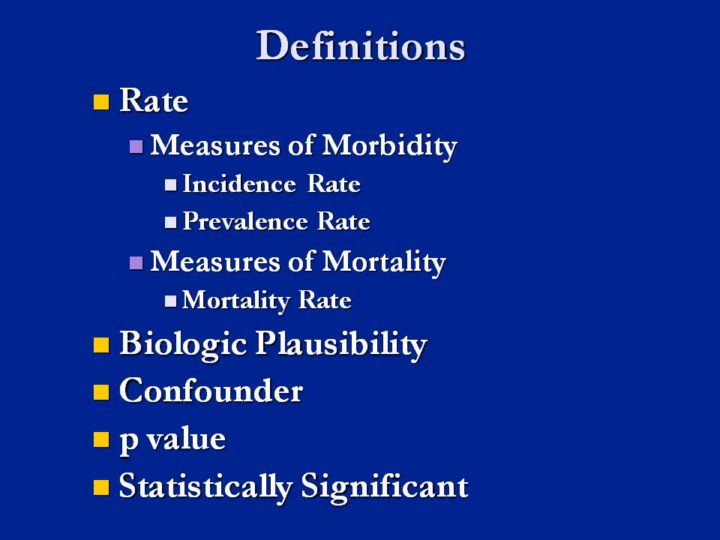| front |1 |2 |3 |4 |5 |6 |7 |8 |9 |10 |11 |12 |13 |14 |15 |16 |17 |18 |19 |20 |21 |22 |23 |24 |25 |26 |27 |28 |29 |30 |31 |32 |33 |34 |35 |review |
 |
Rate is how fast a disease or condition is occurring in a population.
Measures of Morbidity •Incidence is the number of new cases of a particular disease that occurs during a specified period of time divided by the number of persons in the population that is at risk for developing the disease. •Prevalence is the number of affected persons present in the population at a specific time divided by the number of persons in the population at that time.
Measures of Mortality •Mortality Rate is the number of deaths at a specific time divided by the number of persons in the population at that time.
Biologic Plausibility is a theory, based on existing medical literature, that supports the relationship or causal link between physical activity and a particular disease or health outcome.
A confounder is a variable with an effect that is entangled with the effect of physical activity which cannot be easily separated and studied independently. Confounders need to be controlled for using statistical procedures to ensure accurate results. For a variable to be considered a confounder in physical activity epidemiology, it has to be related to both physical activity and the disease and/or health outcome of interest. Confounders in physical activity epidemiology include: age, BMI, and baseline health status. For example, when looking at the relationship between inactivity and physical inactivity, age may be a confounder because both heart disease risk and physical inactivity increases as one ages. In this case, it may be hard to determine if age or physical inactivity lead to the development of heart disease.
p value is used to quantify the degree to which chance may account for an association that was observed in a particular study. Using statistical procedures, researchers decide whether an association between a disease or health outcome and physical inactivity is statistically significant. The p value allows researchers to quantify the probability or likelihood that the association could have occurred by chance alone.
Recommended Readings: Gordis L (2000). Epidemiology (2nd ed.). Philadelphia, PA: W.B. Saunders Company. |